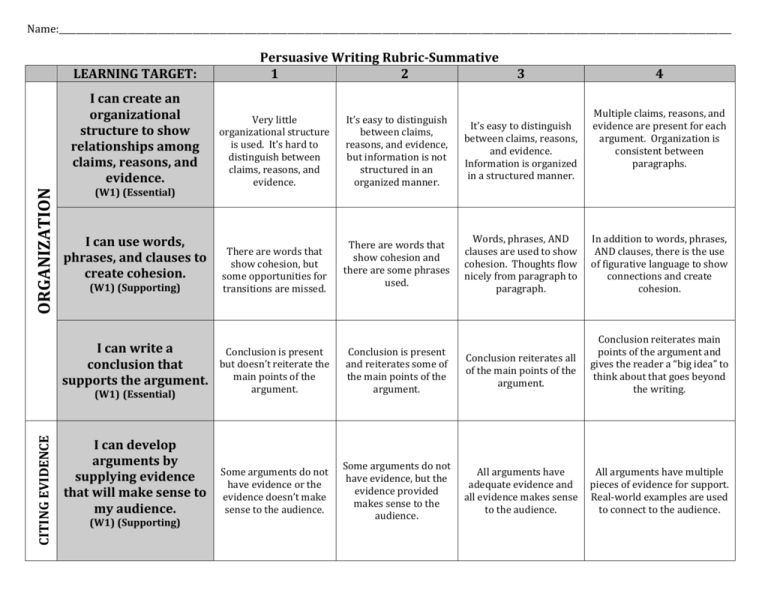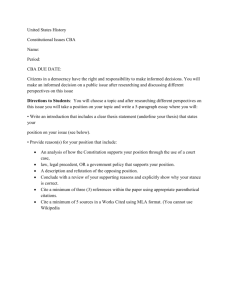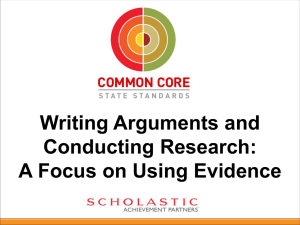I can use words, phrases, and clauses to create cohesion.
advertisement

Name:____________________________________________________________________________________________________________________________________________________________ LEARNING TARGET: ORGANIZATION I can create an organizational structure to show relationships among claims, reasons, and evidence. (W1) (Essential) I can use words, phrases, and clauses to create cohesion. (W1) (Supporting) CITING EVIDENCE I can write a conclusion that supports the argument. Persuasive Writing Rubric-Summative 1 2 Very little organizational structure is used. It’s hard to distinguish between claims, reasons, and evidence. There are words that show cohesion, but some opportunities for transitions are missed. 3 It’s easy to distinguish between claims, reasons, and evidence, but information is not structured in an organized manner. It’s easy to distinguish between claims, reasons, and evidence. Information is organized in a structured manner. There are words that show cohesion and there are some phrases used. Words, phrases, AND clauses are used to show cohesion. Thoughts flow nicely from paragraph to paragraph. (W1) (Essential) Conclusion is present but doesn’t reiterate the main points of the argument. Conclusion is present and reiterates some of the main points of the argument. Conclusion reiterates all of the main points of the argument. I can develop arguments by supplying evidence that will make sense to my audience. Some arguments do not have evidence or the evidence doesn’t make sense to the audience. Some arguments do not have evidence, but the evidence provided makes sense to the audience. All arguments have adequate evidence and all evidence makes sense to the audience. (W1) (Supporting) 4 Multiple claims, reasons, and evidence are present for each argument. Organization is consistent between paragraphs. In addition to words, phrases, AND clauses, there is the use of figurative language to show connections and create cohesion. Conclusion reiterates main points of the argument and gives the reader a “big idea” to think about that goes beyond the writing. All arguments have multiple pieces of evidence for support. Real-world examples are used to connect to the audience. I can write and edit according to the MLA handbook. (L3) (Essential) I can use conventions of standard English LANGUAGE (L1) (Essential) I can establish and maintain a formal style and objective tone by following the conventions of grammar. (W1) (Supporting) I can produce clear and coherent writing in which the development, organization, and style are appropriate to task, purpose, and audience (W4) (Essential) Some arguments don’t have citations support them up and some pieces of evidence are not correctly cited according to MLA. Some arguments do not have citations to support them but all citations given are cited correctly according to MLA. All arguments have citations to support them and all citations are correctly cited according to MLA. All arguments have citations to support them. Citations for quotes-within-quotes or multi-paragraph citations are accurately cited. Some conventions of standard English are present, but there many are grammatical errors that distract the reader. Some conventions of standard English are present, but there are a few grammatical errors that distract the reader. All conventions of standard English are used and there are no distracting errors in the writing. All conventions of standard English are used and there are no errors in the writing. Writing includes many informal phrases and not much third person point of view. Writing includes some informal phrases and does not always use third person point of view. Writing avoids distracting informal phrases and uses third person point of view. Writing rarely makes claims that are knowledgeable, significant, and well supported with factual evidence. Writing mostly makes claims that are knowledgeable, significant, and well supported with factual evidence. Writing is somewhat clear and coherent with an attempt at organization. Development and style are lacking. Little attention is given to task, purpose, and audience. Writing is mostly clear and coherent with an attempt at organization. Development and style are emerging. A decent amount of attention is given to task, purpose, and audience. Writing makes claims that are knowledgeable, significant, and well supported with factual evidence. Writing is clear and coherent. Development and organization is adequate. Writing is appropriate to task, purpose, and audience. Writing avoids all informal phrases like “you guys, contractions like “can’t,” first and second person point of view words like “I” and “you.” Writing makes claims that are knowledgeable, significant, and well supported with evidence. Writing is clear and coherent with advanced development and style. Writing fits task, purpose, and audience perfectly.










